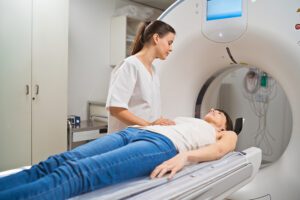What would you like to find out about today?
Why do I need one?
An MRI scan can help to find a possible structural cause of your seizures. Some problems could be:
- Scar tissue from a brain injury, including stroke, a bleed in the brain (haemorrhage) or a previous infection like meningitis or encephalitis
- Tumours
- Problems that have been there since birth
If a problem is seen on an MRI that could be linked to your seizures, it can help support a diagnosis of epilepsy. It can also guide your doctors as to which treatments might be best for you. For some people this might include epilepsy surgery.
In many cases the MRI scan is normal. This does not always mean you don’t have epilepsy. It could be that the problem is too small for MRI to detect. It might be helpful to think of an MRI as an aerial photograph of a town, which can pick up major structures but not the detail of what is happening on the ground.

When should I have an MRI scan?
As well as having an MRI scan around the time of diagnosis, you may also have one later. As part of reviewing your treatment and care, you may be offered more MRI scans. Some reasons for having another MRI are:
- The original scan results were unclear
- Your epilepsy has changed
- You have a type of epilepsy that usually responds to treatment and your seizures have not stopped
- You are being considered for epilepsy surgery
Can I ask for an MRI scan?
The National Institute for Health and Care Excellence (NICE) has guidance on MRI scans and who should have one. Doctors and epilepsy specialists use this guidance to decide whether to refer you for an MRI.
You can ask your GP, epilepsy nurse or specialist to arrange an MRI for you, but they will decide if it is needed. NICE recommends an MRI scan should be done within 6 weeks of the doctor requesting it.
Epilepsy Action has more information about getting the right treatment and care.
Some types of epilepsy are not caused by structural problems in the brain. If you have one of these types of epilepsy, you may not be offered an MRI scan. Some examples of these are:
- Childhood absence epilepsy
- Juvenile absence epilepsy
- Juvenile myoclonic epilepsy
- Epilepsy with generalised tonic-clonic seizures alone
- Self-limited epilepsy with centro-temporal spikes
However, you may still have an MRI with one of these types of epilepsy if medicines have not improved your seizures.
What happens during an MRI?
The MRI scanner is like a tunnel. It’s about 1.5 metres (5 feet) long and is surrounded by a large circular magnet. You lie on a bed, which then slides into the open-ended scanner. During the MRI scan, images of your brain are sent to a computer. MRI images show different types of brain tissue, and any abnormalities in different shades of white, grey and black.
The MRI scan doesn’t hurt. Sometimes the radiographer who does the scan might need to inject a harmless dye into your arm or hand. This is to make some brain tissue or changes show up clearly. The radiographer will ask if you have any allergies or kidney problems before using the dye.
If you are worried about having an MRI scan, you can talk to someone at the Epilepsy Action helpline. You could also let the hospital know beforehand, as there may be extra things they can do to put you at ease.
Functional MRI scan (fMRI)
With a functional MRI you are asked to do something during the scan. They are simple tasks like:
- Thinking of words
- Tapping your thumb against your fingers or other finger movements
- Looking at pictures
- Answering questions from a computer screen
These activities increase the flow of oxygen-rich blood to a particular part of the brain. The fMRI will be able to pick this up.
Laser beam surgery
An MRI is needed as part of laser-guided brain surgery known as Laser Interstitial Thermal Therapy (LITT).
You can find out more about this on our epilepsy surgery page.
Got any questions?
Our expert advisors can help you with any questions you might have about your MRI test or anything else related to living with epilepsy.
Below is a video about having an MRI scan:
It is around 10 minutes long, and shows the whole process of having an MRI scan – right from receiving the letter in the post.
How long will an MRI take?
The MRI scan can last between 15 and 90 minutes.
Is an MRI scan safe?
MRI scans are one of the safest medical procedures and there is no evidence that they cause harm to the human body. But, the powerful magnets used can affect metal implants and devices.
The medical team will need to know about any metal in your body, including if you have a vagus nerve stimulator (VNS), deep brain stimulator (DBS), pacemaker, cochlear implant or braces on your teeth. It will depend on the materials used as to how safe they will be in an MRI.
If you have a vagus nerve stimulator (VNS) fitted, your epilepsy specialist may switch it off before you have the scan.
If you are unable to have an MRI scan, your epilepsy specialist nurse or doctor may be able to arrange for you to have a different type of scan. MRI scans are also not usually recommended if you are pregnant, unless needed for emergency medical treatment.
How will I feel during my MRI scan?
The MRI is noisy when it is scanning, but you will be given earplugs or headphones to protect your hearing. The inside of the scanner is like a hollow open-ended tube. You will be given a button to hold. You can press this to tell the radiographer if you feel uncomfortable and want the scan to stop part way through. You will also be able to talk to the radiographer through an intercom from the scanner, but will be asked to lie still during the actual scan.
Depending on where you have your scan, you might be able to listen to music to help you to relax. A relative or friend might be able to go into the room with you.
If you feel nervous, or can’t keep still while the scan is being done, you could be offered medicine to help you relax or sleep. Young children and people with learning disabilities may need a general anaesthetic. This is to make sure that they keep completely still during the scan. Any movement can cause the scan pictures to be blurred. If you think you may need anaesthetic, this needs to be planned in advance.
What will happen after my MRI scan?
After your scan, a radiologist will study the pictures taken by the MRI. They will then send your results to the doctor who arranged your scan. This will generally be your epilepsy specialist. It usually takes a week or two for your MRI results to come through.
For some types of brain problems (sometimes called lesions) surgery to control your seizures may be more effective than epilepsy medicines. Your epilepsy specialist can talk to you about your options and any risks or benefits to you.
It is still possible for your seizures to be caused by damage or abnormalities in your brain, even if nothing is found on the MRI scan. If your seizures are not controlled by epilepsy medicines, NICE say that you should be referred to a specialist centre for assessment, even if the MRI results are normal.
You might need to have other tests to help with your diagnosis and treatment. You could have another MRI scan, or a different test such as an EEG.


